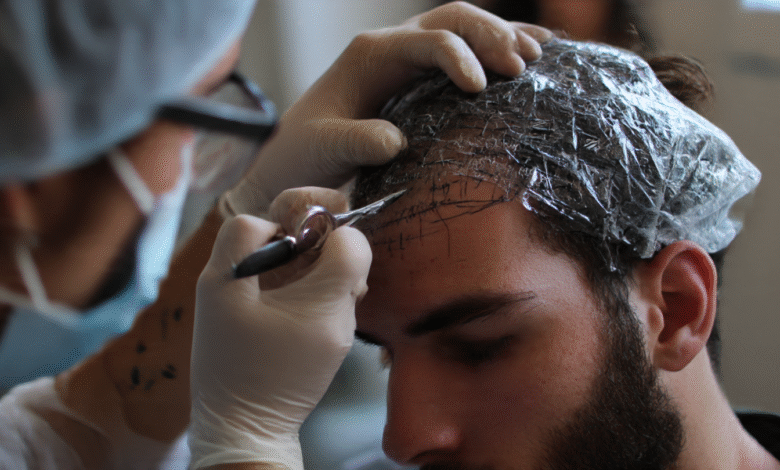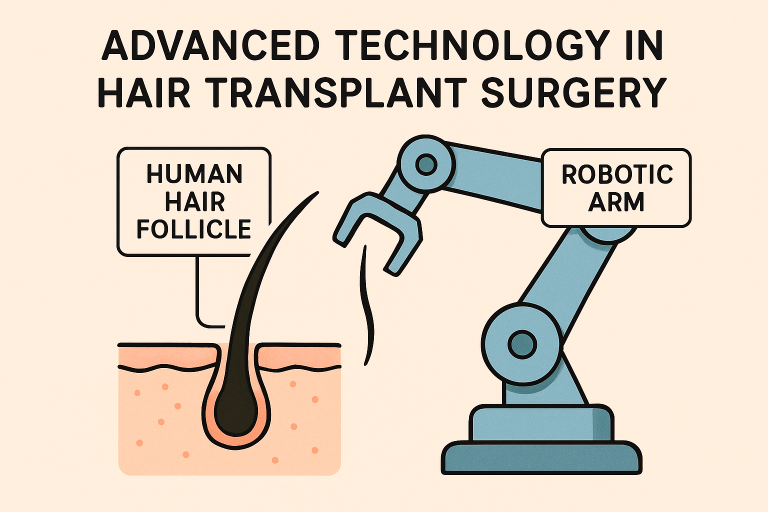How New Technology is Changing Hair Transplant Surgery
Discover how AI, robotics, and new technologies are transforming hair transplant surgery—making procedures more precise, comfortable, and effective.

Key Takeaways
- Robotic hair transplant platforms, such as the ARTAS system, significantly improve the accuracy and consistency of hair follicle extraction and placement.
- Artificial Intelligence (AI) enables the creation of customized treatment plans, resulting in natural-looking, long-lasting outcomes tailored to each individual client.
- Minimally invasive procedures, such as Follicular Unit Extraction (FUE), significantly reduce scarring and shorten recovery time.
- Cutting-edge fields, such as 3D bioprinting and nanotechnology, promise transformational advancements in future hair restoration therapies.
Technological advancements are impacting nearly every aspect of health and wellness, and hair transplant surgery is no exception. In clinics around the world, including leading facilities such as the hair transplant clinic Bethesda, MD, these innovations are making procedures more effective, comfortable, and accessible for a broader range of patients. New tools, robotic systems, and artificial intelligence are enabling surgeons to deliver better results while minimizing downtime and patient discomfort.
Once considered an option only for severe cases of hair loss or for those willing to endure significant recovery time, today’s hair transplant surgeries are remarkably advanced. Patients now benefit from targeted and strategic procedures, and emerging breakthroughs hint at a future where hair restoration becomes easier and more successful than ever before. These innovations are not only refining the quality of results but are also expanding treatment possibilities for a wider demographic.
Whether you’re considering a transplant for the first time, evaluating your options for the future, or simply interested in medical technology, understanding these advances can be helpful in making informed choices. With modern advancements, hair restoration has evolved to be as much about precision and science as it is about artistry and aesthetics.
Discover how everything from robotic systems to artificial intelligence and emerging techniques is shaping hair restoration’s future—offering options that were previously unimaginable just a decade ago.
Robotic-Assisted Hair Transplantation
Robotic systems, most notably the ARTAS platform, are transforming the hair transplant process. These next-generation systems incorporate high-resolution imaging and machine learning to identify the strongest, healthiest hair follicles for extraction, ensuring both the donor and recipient areas are treated with utmost care. According to the American Society of Plastic Surgeons, advancements in robotic and artificial intelligence technologies continue to refine accuracy and efficiency in hair restoration procedures. Robotic arms perform repetitive actions, such as follicular unit harvesting, with consistently greater precision than even the most skilled human hands. This technology leads to a decrease in human error and more reliable results.
Surgeons benefit from enhanced visualization, automated measurements, and real-time data on each graft, while patients benefit from shorter procedure lengths and reduced tissue trauma. This leap forward helps ensure that hair grows naturally and that the recovery process is smooth and predictable, with fewer complications and better cosmetic results.

Artificial Intelligence in Hair Restoration
The integration of artificial intelligence (AI) in hair transplantation is leading to a new era of personalization and precision. AI-powered software analyzes patient photos, genetic profiles, and even scalp tissue metrics to design individualized hairlines and treatment plans. By leveraging enormous datasets and predictive algorithms, clinicians can map the optimal density, direction, and angle for every follicle placement. This results in a seamless blend with existing hair and a natural appearance tailored to the unique contours of each patient’s head.
During the procedure, AI provides real-time data and feedback, increasing accuracy and preserving healthy tissue. This ongoing assessment also helps adapt strategies as needed to produce the best outcome during surgery. AI isn’t just improving cosmetic results—it’s also helping set patient expectations, streamline scheduling, and support aftercare with follow-up recommendations and monitoring.
Minimally Invasive Techniques
Among the most significant advances of the past decade is the widespread adoption of minimally invasive hair transplant procedures, such as Follicular Unit Extraction (FUE). Rather than removing and relocating entire strips of scalp as with traditional methods, FUE harvests individual hair follicles—typically using specialized punches or blades—allowing for maximum natural density without noticeable scarring. This innovation significantly reduces both operating and recovery times, producing undetectable results, as supported by research featured in Healthline.
Newer techniques, such as Sapphire FUE, utilize superior, ultra-fine blades that further minimize trauma to the scalp, accelerate healing, and enhance the precision of graft placement. As a result, more patients—regardless of skin type or hair texture—can now experience safe and efficient hair restoration with minimal risk.
Emerging Technologies
The future of hair transplantation appears even brighter thanks to innovations on the research horizon, such as 3D bioprinting and nanotechnology. Scientists are actively working to develop 3D bioprinting methods that enable the engineering of functional hair follicles in the laboratory, which can be transplanted into patients lacking suitable donor hair. This breakthrough could one day provide a nearly limitless supply for those with advanced hair loss or thinning. Meanwhile, nanotechnology promises to enhance the delivery of regenerative treatments directly to hair follicles, jump-starting natural growth mechanisms at the cellular level.
While still in clinical development, these breakthroughs represent the next leap toward non-invasive procedures and potentially permanent solutions to hair loss. As these innovations progress, the field will be able to serve even broader patient groups and provide more natural-looking, lasting results.
Conclusion
The integration of robotics, AI, and minimally invasive approaches is transforming hair transplant surgery—making it safer, more effective, and more accessible than ever before. Looking ahead, innovations like 3D bioprinting and nanotechnology promise to further advance the possibilities for anyone seeking natural hair restoration. As data-driven solutions and new technologies become standard practice, patients can expect more personalized care, greater satisfaction, and outstanding results from their hair restoration journey.











